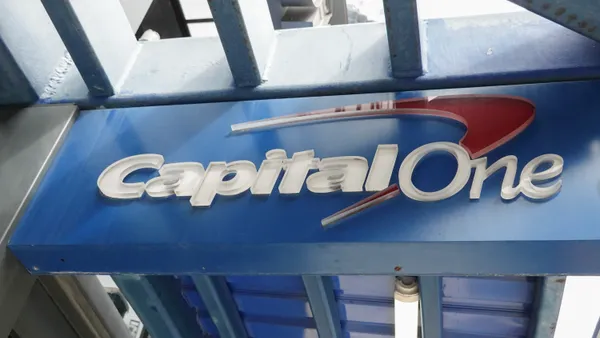Dive Brief:
- Goldman Sachs expanded beta testing of its highly anticipated checking account this week to include all of its more than 20,000-person U.S.-based workforce, Stephanie Cohen, the bank’s global co-head of consumer and wealth management, told CNBC in a statement Thursday.
- The bank is expected to release the product to the public this year, Goldman CFO Denis Coleman told analysts this month. The accounts, initially projected to debut in 2021, have seen delays as the bank worked through the product roadmap.
- The fee-free digital-first checking accounts will include a physical debit card and offer a competitive interest rate, Cohen said, according to American Banker. However, a company spokesperson did not detail the specific rate.
Dive Insight:
"As beta participants, [Goldman's U.S.-based employees] have the opportunity to be the first to explore the new product, test select features and share feedback with us," Cohen said in a statement emailed to CNBC and American Banker. "This beta is only the beginning of what we hope will soon become the primary checking account for tens of millions of customers."
Goldman, at a February strategic update, made clear that it is adjusting its expectations with regard to Marcus, the consumer-banking unit that launched in 2016.
The bank two years ago said it wanted to more than double Marcus' deposit balances by 2025 — from $60 billion to $125 billion. It surpassed $100 billion by September 2021. With the old target seemingly well in hand, Goldman in February announced it would push for $150 billion by 2024.
Goldman also said this year it is aiming to more than double revenue at Marcus — to $4 billion by 2024, from $1.5 billion as of 2021. The bank set out in 2020 to nearly triple — to $20 billion, from $7 billion — its consumer loan and card balances by 2025. In February, it updated that target to $30 billion by 2024.
Marcus offers high-yield savings accounts and no-fee personal loans of up to $40,000. It launched its Marcus platform to U.K. users in 2018. The savings option was popular enough that the bank stopped taking new applications for savings accounts in June 2020 to keep its deposits under a £25 billion threshold that would necessitate stricter regulation. It resumed accepting new applications in February 2021 but has historically poured its consumer deposits back into its investment-banking operations rather than broaden its digital offerings.
In a recent call with analysts, however, Coleman pointed to the Goldman’s recent growth in consumer banking.
"To give you a sense, our active customers in the consumer space are north of 13 million now, and that number in the fourth quarter was less than 10 million," he said. "So we continue to see attractive active customer acquisition, both organically and inorganically, which is an important piece of the strategy."
In addition to its high-yield savings platform, Goldman last year launched Marcus Invest, a robo-advisory service that allows customers to open an account for as little as $1,000 with an annual fee of 0.35%.
Goldman's consumer-banking division has also seen a boon from the Apple Card since it launched in August 2019.











